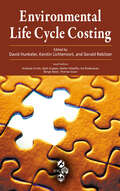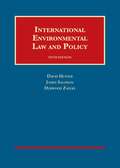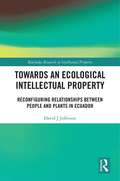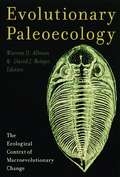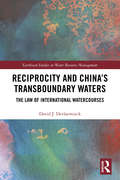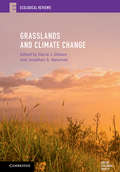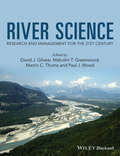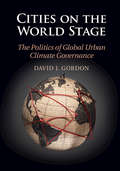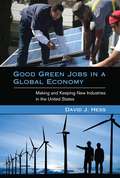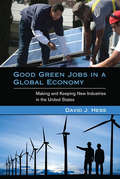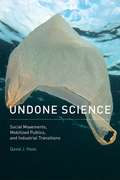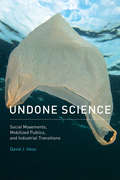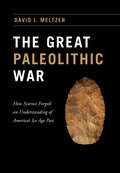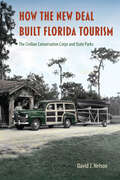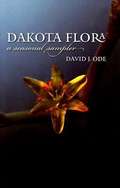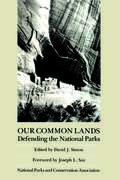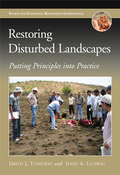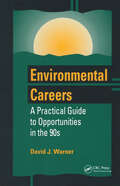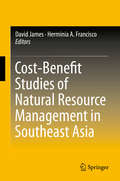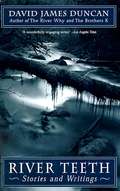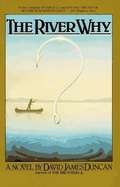- Table View
- List View
Environmental Life Cycle Costing
by David Hunkeler Kerstin Lichtenvort Gerald RebitzerBalances Scientific and Economic Points of View to Thoroughly Address Management IssuesResponding to the need for clarification and benchmarks, Environmental Life Cycle Costing provides the fundamental basis on which to establish a definitive methodology. Clearly defining environmental LCC, this book balances scientific and econom
International Environmental Law And Policy (University Casebook)
by James Salzman David Hunter Durwood ZaelkeThe most widely adopted text in the field, this comprehensive, multidisciplinary casebook analyzes all aspects of international environmental law and policy, including the major environmental treaty regimes, customary law principles and the development and evolution of soft law norms. It emphasizes the dynamic nature of the law-making process, including global environmental diplomacy and the critical role of non-state actors, including scientists, NGOs, and business. It presents the binding norms of international environmental law, and explains how international cooperation facilitates and strengthens global environmental governance through setting national priorities, coordinating bilateral and multilateral science, financing, technology sharing, and capacity building.
Towards an Ecological Intellectual Property: Reconfiguring Relationships Between People and Plants in Ecuador (Routledge Research in Intellectual Property #1)
by David J JeffersonThis book focuses on analysing how legal systems set the terms for interactions between human beings and plants. The story that the book recounts is one of experimental lawmaking in Ecuador, a country where over the past decade, governmental officials and civil society advocates have attempted to reconfigure how human individuals and institutions relate to nature, by following an "eco-centric" approach to lawmaking. In doing so, Ecuadorian legislators, administrators, and judges have taken seriously the ontologies of non-human entities, including plants, through a process that has required the continuous navigation of tensions with certain "logics" that pervade conventional legal regimes. The book endeavours to disrupt these conventional assumptions and approaches to lawmaking by taking seriously alternative strategies to reconstitute interactions between people and plants. In doing so, the book argues in favour of an "ecological turn" in laws that govern vegetal life. The analysis is based on a close examination of the experiences that lawmakers in Ecuador have had when experimenting with innovative approaches to re-form relationships between human and non-human beings. Concretely, these experiments have yielded constitutional, legislative, and regulatory changes that inform the inquiry of how intellectual property and plant genetic resources laws – both in Ecuador and worldwide – could become more "ecological" in nature. The argument that the book develops is based on extensive ethnographic fieldwork and empirical research in Ecuador, complemented by archival and doctrinal legal analysis. The contents of the book will be of interest to an academic audience of legal scholars and postgraduate students in law, in addition to scholars and students in the fields of anthropology, sociology, socio-legal studies, and science and technology studies.
Evolutionary Paleoecology: The Ecological Context of Macroevolutionary Change
by David J. Bottjer Warren AllmonOne of the most important questions we can ask about life is "Does ecology matter?" Most biologists and paleontologists are trained to answer "yes," but the exact mechanisms by which ecology matters in the context of patterns that play out over millions of years have never been entirely clear. This book examines these mechanisms and looks at how ancient environments affected evolution, focusing on long-term macroevolutionary changes as seen in the fossil record. Evolutionary paleoecology is not a new discipline. Beginning with Darwin, researchers have attempted to understand how the environment has affected evolutionary history. But as we learn more about these patterns, the search for a new synthetic view of the evolutionary process that integrates species evolution, ecology, and mass extinctions becomes ever more pressing. The present volume is a benchmark sampler of active research in this ever more active field.P.K. Strother, Choice
The Vegetation of Antarctica through Geological Time
by David J. Cantrill Imogen PooleThe fossil history of plant life in Antarctica is central to our understanding of the evolution of vegetation through geological time and also plays a key role in reconstructing past configurations of the continents and associated climatic conditions. This book provides the only detailed overview of the development of Antarctic vegetation from the Devonian period to the present day, presenting Earth scientists with valuable insights into the break up of the ancient supercontinent of Gondwana. Details of specific floras and ecosystems are provided within the context of changing geological, geographical and environmental conditions, alongside comparisons with contemporaneous and modern ecosystems. The authors demonstrate how palaeobotany contributes to our understanding of the palaeoenvironmental changes in the southern hemisphere during this period of Earth history. The book is a complete and up-to-date reference for researchers and students in Antarctic palaeobotany and terrestrial palaeoecology.
Reciprocity and China’s Transboundary Waters: The Law of International Watercourses (Earthscan Studies in Water Resource Management)
by David J. DevlaeminckUtilizing the principle of reciprocity, Reciprocity and China’s Transboundary Waters: The Law of International Watercourses analyses the past, present and future of the law of international watercourses with a particular focus on China. As a legal principle, reciprocity plays a strong role in the formation, interpretation and maintenance of international law. Implementing this framework, the book examines the development of the law of international watercourses, highlighting how this basic legal principle is a foundational notion. It applies the framework to China and offers insights into one of the most important transboundary states in Asia. As a primarily upstream state, China is of great significance to its transboundary neighbours; however, there remain significant hurdles, misunderstandings and mistrust between China and its neighbours. China is faced with a complex challenge - how to meet its own development needs while also taking into consideration its primarily downstream neighbours? By focusing on this prominent state this work not only fosters a greater understanding of the law of international watercourses within China, but also clarifies and challenges current perceptions of China’s transboundary water treaty practice. More generally, the book provides a past, present and future view on international watercourse law, starting with an analysis of the UN Watercourses Convention and UNECE Water Convention leading to a discussion of reciprocity’s continued influence as well as charting a path forward. This book will be of great interest to legal students and scholars with an interest in international watercourses, environmental politics and international law, as well as students and scholars interested in Chinese politics and natural resource management and conflict.
The Land Beneath the Ice: The Pioneering Years of Radar Exploration in Antarctica
by David J. DrewryA wondrous story of scientific endeavor—probing the great ice sheets of AntarcticaFrom the moment explorers set foot on the ice of Antarctica in the early nineteenth century, they desired to learn what lay beneath. David J. Drewry provides an insider’s account of the ambitious and often hazardous radar mapping expeditions that he and fellow glaciologists undertook during the height of the Cold War, when concerns about global climate change were first emerging and scientists were finally able to peer into the Antarctic ice and take its measure.In this panoramic book, Drewry charts the history and breakthrough science of radio-echo sounding, a revolutionary technique that has enabled researchers to measure the thickness and properties of ice continuously from the air—transforming our understanding of the world’s great ice sheets. To those involved in this epic fieldwork, it was evident that our planet is rapidly changing, and its future depends on the stability and behavior of these colossal ice masses. Drewry describes how bad weather, downed aircraft, and human frailty disrupt the most meticulously laid plans, and how success, built on remarkable international cooperation, can spawn institutional rivalries.The Land Beneath the Ice captures the excitement and innovative spirit of a pioneering era in Antarctic geophysical exploration, recounting its perils and scientific challenges, and showing how its discoveries are helping us to tackle environmental challenges of global significance.
Grasslands and Climate Change (Ecological Reviews)
by David J. Gibson Jonathan A. NewmanGrasslands are the most extensive terrestrial biome on Earth and are critically important for forage, biodiversity, and ecosystem services. This book brings together an international team of researchers to review scientific knowledge of the effects of climate change on world grasslands, a process we are only just starting to understand. Part I assesses how climate change will impact on the distribution of grasslands, as well as production, biogeochemical cycling and ecosystem services. Part II considers the consequences for the spread of invasive species, demographic change, trophic-level relationships, soil biota, and evolutionary change within grassland biodiversity. Part III proposes how ecologists can respond to climate change effects, focusing on grazing systems, cultural ecology, range management, and restoration. The concluding chapter sets grasslands in the context of the Anthropocene era and identifies the vital research and conservation needs for grassland ecosystems to remain environmentally sustainable under climate change.
River Science: Research and Management for the 21st Century
by David J. Gilvear Malcolm T. Greenwood Martin C. Thoms Paul J WoodRiver Science is a rapidly developing interdisciplinary field at the interface of the natural sciences, engineering and socio-political sciences. It recognises that the sustainable management of contemporary rivers will increasingly require new ways of characterising them to enable engagement with the diverse range of stakeholders.This volume represents the outcome of research by many of the authors and their colleagues over the last 40 years and demonstrates the integral role that River Science now plays in underpinning our understanding of the functioning of natural ecosystems, and how societal demands and historic changes have affected these systems. The book will inform academics, policy makers and society in general of the benefits of healthy functioning riverine systems, and will increase awareness of the wide range of ecosystem goods and services they provide.
Cities on the World Stage: The Politics of Global Urban Climate Governance
by David J. GordonCities are playing an ever more important role in the mitigation and adaption to climate change. This book examines the politics shaping whether, how and to what extent cities engage in global climate governance. By studying the C40 Cities Climate Leadership Group, and drawing on scholarship from international relations, social movements, global governance and field theory, the book introduces a theory of global urban governance fields. This theory links observed increases in city engagement and coordination to the convergence of C40 cities around particular ways of understanding and enforcing climate governance. The collective capacity of cities to produce effective and socially equitable global climate governance is also analysed. Highlighting the constraints facing city networks and the potential pitfalls associated with a city-driven global response, this assessment of the transformative potential of cities will be of great interest to researchers, graduate students and policymakers in global environmental politics and policy.
Good Green Jobs in a Global Economy
by David J. HessGood Green Jobs in a Global Economy is the first book to explore the broad implications of the convergence of industrial and environnmental policy in the United States. Under the banner of "green jobs," clean energy industries and labor, environmental, and antipoverty organizations have forged "blue-green" alliances and achieved some policy victories, most notably at the state and local levels. In this book, David Hess explores the politics of green energy and green jobs, linking the prospect of a green transition to tectonic shifts in the global economy. He argues that the relative decline in U. S. economic power sets the stage for an ideological shift, away from neoliberalism and toward "developmentalism," an ideology characterized by a more defensive posture with respect to trade and a more active industrial policy. After describing federal green energy initiatives in the first two years of the Obama administration, Hess turns his attention to the state and local levels, examining demand-side and supply-side support for green industry and local small business. He analyzes the successes and failures of green coalitions and the partisan patterns of support for green energy reform. This new piecemeal green industrial policy, Hess argues, signals a fundamental challenge to anti-interventionist beliefs about the relationship between the government and the economy.
Good Green Jobs in a Global Economy: Making and Keeping New Industries in the United States (Urban and Industrial Environments)
by David J. HessAn examination of the politics of green jobs that foresees a potential ideological shift away from neoliberalism toward “developmentalism.”Good Green Jobs in a Global Economy is the first book to explore the broad implications of the convergence of industrial and environnmental policy in the United States. Under the banner of “green jobs,” clean energy industries and labor, environmental, and antipoverty organizations have forged “blue-green” alliances and achieved some policy victories, most notably at the state and local levels. In this book, David Hess explores the politics of green energy and green jobs, linking the prospect of a green transition to tectonic shifts in the global economy. He argues that the relative decline in U.S. economic power sets the stage for an ideological shift, away from neoliberalism and toward “developmentalism,” an ideology characterized by a more defensive posture with respect to trade and a more active industrial policy.After describing federal green energy initiatives in the first two years of the Obama administration, Hess turns his attention to the state and local levels, examining demand-side and supply-side support for green industry and local small business. He analyzes the successes and failures of green coalitions and the partisan patterns of support for green energy reform. This new piecemeal green industrial policy, Hess argues, signals a fundamental challenge to anti-interventionist beliefs about the relationship between the government and the economy.
Undone Science: Social Movements, Mobilized Publics, and Industrial Transitions
by David J. HessAs the fields of social movement studies (SMS) and science and technology studies (STS) have diversified in topical focus, they have moved closer to each other. SMS has turned toward the study of nonstate targets and institutionalized repertoires of action, just as STS has turned to expertise and publics. In Undone Science, David Hess argues that a theoretical integration of core concepts in the two fields is now possible, and he presents just such a synthesis. Hess focuses on industrial transition movements -- mobilized counterpublics of activists, advocates, entrepreneurs, and other agents of change -- and examines several areas of common ground between the two fields relevant to these movements. His account reveals the problem of "undone science" -- areas of research potentially valuable to the goals of industrial transition movements that have been systematically ignored. Each chapter begins with a problem in SMS, discusses the relevant STS literature, describes new concepts and findings that have emerged, and offers applications to examples that range from nanotechnology and climate science denialism to conflicts based on race, class, and gender. Topics include the epistemic dimension of the political opportunity structure, networks of counterpublic knowledge, and regime resistance in industrial transition.
Undone Science: Social Movements, Mobilized Publics, and Industrial Transitions (The\mit Press Ser.)
by David J. HessA theoretical integration of science and technology studies and social movement studies that finds both common ground and “undone” research.As the fields of social movement studies (SMS) and science and technology studies (STS) have diversified in topical focus, they have moved closer to each other. SMS has turned toward the study of nonstate targets and institutionalized repertoires of action, just as STS has turned to expertise and publics. In Undone Science, David Hess argues that a theoretical integration of core concepts in the two fields is now possible, and he presents just such a synthesis. Hess focuses on industrial transition movements—mobilized counterpublics of activists, advocates, entrepreneurs, and other agents of change—and examines several areas of common ground between the two fields relevant to these movements. His account reveals the problem of “undone science”—areas of research potentially valuable to the goals of industrial transition movements that have been systematically ignored. Each chapter begins with a problem in SMS, discusses the relevant STS literature, describes new concepts and findings that have emerged, and offers applications to examples that range from nanotechnology and climate science denialism to conflicts based on race, class, and gender. Topics include the epistemic dimension of the political opportunity structure, networks of counterpublic knowledge, and regime resistance in industrial transition.
Mabberley's Plant-Book
by David J. MabberleyMabberley's Plant-Book is internationally accepted as an essential reference text for anyone studying, growing or writing about plants. In over 20,000 entries this comprehensive dictionary provides information on every family and genus of seed-bearing plant (including gymnosperms) plus ferns and clubmosses, combining taxonomic details and uses with English and other vernacular names. In this new edition each entry has been updated to take into consideration the most recent literature, notably the great advances from molecular analyses, and over 1650 additional new entries (including ecologically and economically important genera of mosses) have been added, ensuring that Mabberley's Plant-Book continues to rank among the most practical and authoritative botanical texts available.
The Great Paleolithic War: How Science Forged an Understanding of America's Ice Age Past
by David J. MeltzerFollowing the discovery in Europe in the late 1850s that humanity had roots predating known history and reaching deep into the Pleistocene era, scientists wondered whether North American prehistory might be just as ancient. And why not? The geological strata seemed exactly analogous between America and Europe, which would lead one to believe that North American humanity ought to be as old as the European variety. This idea set off an eager race for evidence of the people who might have occupied North America during the Ice Age--a long, and, as it turned out, bitter and controversial search. In The Great Paleolithic War, David J. Meltzer tells the story of a scientific quest that set off one of the longest-running feuds in the history of American anthropology, one so vicious at times that anthropologists were deliberately frightened away from investigating potential sites. Through his book, we come to understand how and why this controversy developed and stubbornly persisted for as long as it did; and how, in the process, it revolutionized American archaeology.
How the New Deal Built Florida Tourism: The Civilian Conservation Corps and State Parks
by David J. NelsonFlorida Historical Society Rembert Patrick Award Florida Book Awards, Silver Medal for Florida Nonfiction Countering the conventional narrative that Florida’s tourism industry suffered during the Great Depression, this book shows that the 1930s were, in reality, the starting point for much that characterizes modern Florida’s tourism. David Nelson argues that state and federal government programs designed to reboot the economy during this decade are crucial to understanding the state today. Nelson examines the impact of three connected initiatives—the federal New Deal, its Civilian Conservation Corps program (CCC), and the CCC’s creation of the Florida Park Service. He reveals that the CCC designed state parks to reinforce the popular image of Florida as a tropical, exotic, and safe paradise. The CCC often removed native flora and fauna, introduced exotic species, and created artificial landscapes that were then presented as natural. Nelson discusses how Florida business leaders benefitted from federally funded development and the ways residents and business owners rejected or supported the commercialization and shifting cultural identity of their state. A detailed look at a unique era in which the state government sponsored the tourism industry, helped commodify natural resources, and boosted mythical ideas of the “Real Florida” that endure today, this book makes the case that the creation of the Florida Park Service is the story of modern Florida.
Dakota Flora: A Seasonal Sampler
by David J. OdeOde (botanist/ecologist, South Dakota Department of Game, Fish and Parks) collects revised, reprinted columns entitled "Dakota Flora" that he wrote for the South Dakota Conservation Digest from 1987 to 2005. The short odes to individual plants (e.g., buffalo currant, Dakota buckwheat, and Black Hills spruce) are organized by season. The book includes color photos, a listing of the scientific names of the plants mentioned, and an annotated list of plant field guides. Annotation ©2007 Book News, Inc., Portland, OR (booknews.com)
Second Nature: Environmental Enrichment for Captive Animals
by Michael Hutchins Jill D. Mellen David J. ShepherdsonGrowing recognition of the complexity of animals' physical, social, and psychological lives in the wild has led both zookeepers and the zoo-going public to call for higher environmental standards for animals in captivity.Bringing together the work of animal behaviorists, zoo biologists, and psychologists, Second Nature explores a range of innovative strategies for environmental enrichment in laboratories and marine parks, as well as in zoos. From artificial fleeing-prey devices for leopards to irregular feeding schedules for whales, the practices discussed have resulted in healthier, more relaxed animals that can breed more easily and can exert some control over their environments. Moving beyond the usual studies of primates to consider the requirements of animals as diverse as reptiles, amphibians, marine mammals, small cats, hooved grazers, and bears, contributors argue that whether an animal forages in the wild or plays computer games in captivity, the satisfaction its activity provides--rather than the activity itself--determines the animal's level of physical and psychological well-being.Second Nature also discusses the ways in which environmental enrichment can help zoo-bred animals develop the stamina and adaptability for survival in the wild, and how it can produce healthier lab animals that yield more valid test results. Providing a theoretical framework for the science of environmental enrichment in a variety of settings, the book renews and extends a humane approach to the keeping and conservation of animals.From the Trade Paperback edition.
Our Common Lands: Defending The National Parks
by David J. Simon Joseph L. SaxThis accessible book explains the complexities of key environmental laws and how they can be used to protect our national parks. It includes discussions of successful and unsuccessful attempts to use the laws and how the courts have interpreted them.
Restoring Disturbed Landscapes
by John Ludwig David J. TongwayRestoring Disturbed Landscapes is a hands-on guide for individuals and groups seeking to improve the functional capacity of landscapes. The book presents a five-step, adaptive procedure for restoring landscapes that is supported by proven principles and concepts of ecological science. Abundantly illustrated with photos and figures that clearly explain concepts outlined in the book, Restoring Disturbed Landscapes is an engaging and accessible work designed specifically for restoration practitioners with limited training or experience in the field. It tells restorationists where to start, what information they need to acquire, and how to apply this information to their specific situations.
Environmental Careers: A Practical Guide to Opportunities in the 90s
by David J. WarnerEnvironmental Careers presents a broad-based, yet concise survey of employment opportunities in the environmental field. The book stresses the need for students to develop a strong technical background in the sciences to be effective in understanding and solving complex environmental problems. It also emphasizes the importance of developing relevant work experience through internships or volunteer work to help find entry-level employment in the environmental field. Environmental Careers includes opportunities in natural resources management, environmental protection, environmental health and safety, environmental education, allied environmental careers, and non-degree technical careers. Important issues for students, guidance counselors, and mid-career changers, such as salaries, characteristics of employers, and the latest trends in demands for environmental professionals, are addressed. The book also presents the 10 best career prospects for the 1990s and offers guidance on developing and implementing a personal action plan for pursuing an environmental career.
Cost-Benefit Studies of Natural Resource Management in Southeast Asia
by David James Herminia A. FranciscoThis book applies cost-benefit analysis techniques in the management of environment and natural resources in developing countries of the Southeast Asian region and presents a compendium of studies conducted by researchers supported by the Economy and Environment Program for Southeast Asia (EEPSEA). It emphasizes the close relationship between the environment and natural resources and economic development in such countries, addressing a wide range of problems that can be understood using economic evaluation techniques. General guidelines for conducting economic appraisals are provided, with the case studies illustrating how they can be applied in a developing country context. Cost-Benefit Analysis Application in Environmental and Natural Resource Management in Southeast Asia serves as essential reading for teachers, researchers, students and practitioners in environmental and natural resource economics, economic development and key issues facing policymakers in the Southeast Asian region.
River Teeth: Stories and Writings
by David James DuncanIn his passionate, luminous novels, David James Duncan has won the devotion of countless critics and readers, earning comparisons to Harper Lee, Tom Robbins, and J.D. Salinger, to name just a few. Now Duncan distills his remarkable powers of observation into this unique collection of short stories and essays. At the heart of Duncan's tales are characters undergoing the complex and violent process of transformation, with results both painful and wondrous. Equally affecting are his nonfiction reminiscences, the "river teeth" of the title. He likens his memories to the remains of old-growth trees that fall into Northwestern rivers and are sculpted by time and water. These experiences--shaped by his own river of time--are related with the art and grace of a master storyteller. In River Teeth, a uniquely gifted American writer blends two forms, taking us into the rivers of truth and make-believe, and all that lies in between.
The River Why
by David James DuncanNot in recent memory has there been such a unique and vibrant fictional character--a character who could make us laugh so easily, feel so deeply, who speaks with such startling truth about the way we live, as Gus Orviston--the irreverent young fly fisherman in "The River Why."
